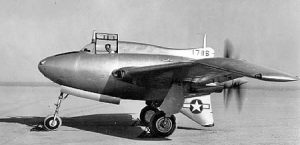The initial idea for the XP-56 was quite radical for 1939. It was to have no horizontal tail, only a small vertical tail, used an experimental engine, and be produced using a novel metal, magnesium. The aircraft was to be a wing with a small central fuselage added to house the engine and pilot. It was hoped that this configuration would have less aerodynamic drag than a conventional airplane.
Northrop constructed the XP-56 using magnesium alloy for the airframe and skin because aluminum was forecast to be in short supply due to wartime demands. At the time there was little experience with magnesium aircraft construction.
The first engine runs in the aircraft were conducted in late March 1943, but excessive propeller shaft flex caused the engine to fail. Pratt & Whitney did not send another engine until August, causing a five-month delay.

Taxi tests of the XP-56 began on 6 April 1943 and showed a serious yaw problem… (sound familiar?)…At first, it was thought to be caused by uneven wheel brakes, and considerable effort was placed into fixing this problem. Manual hydraulic brakes were installed and the aircraft flew on 30 September 1943 at Muroc Air Base in southern California. Eventually, the yaw problem was traced to a lack of aerodynamic stability, and to fix this the upper vertical stabilizer was enlarged from a mere stub to one virtually matching the ventral unit in shape and area.
After a number of flights, the first XP-56 was destroyed 8 October 1943 when the tire on the left gear blew out during a high-speed (~130 mph) taxi across Muroc Dry Lake. The pilot, John Myers, survived with minor injuries which he credited to his innovative wearing of a polo player’s helmet.[2] Myers was the test pilot for several of Northrop’s radical designs during the war.[3]
(1)Source: Wikipedia
